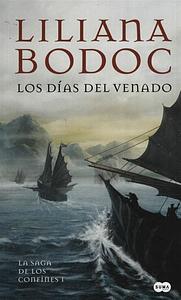Take a photo of a barcode or cover
Una mezcla de las temas de J.R.R. Tolkien, la estila de narración de Ursula K. Le Guin, y elementos únicos de las historias de los pueblos americanos. No hay nada como este en mi lengua materna (como Olvidado Rey Gudú, fantasia española realmente es un tesoro).
En este libro, hay un gran mal (que es el hijo, literalmente de la muerte) que vive tras el océano. El ya ha conquistado las tierras antiguas, y ahora su ojo (como Sauron) mueve a las tierras fértiles. Los pueblos diversas desde huiskildes (mapuches) en el sur al Reino del Sol (los aztecas) en el norte reúnan un concilio para decidir como combatir este mal. Como en la trilogía del señor de los anillos, un problema serio es la desunión entre los pueblos diferentes, y la voz (y la lógica) corrompiendo del enemigo.
En contra de Tolkien, hay mucha más énfasis en los poderes del mundo natural. El mago, que organiza la resistencia, me parece mucho más a Radagast que a Gandalf. La narración es similar a la de Ursula K. Le Guin, algo abstracto y lejos de los mentes de los personajes (como en un mito).
En este libro, hay un gran mal (que es el hijo, literalmente de la muerte) que vive tras el océano. El ya ha conquistado las tierras antiguas, y ahora su ojo (como Sauron) mueve a las tierras fértiles. Los pueblos diversas desde huiskildes (mapuches) en el sur al Reino del Sol (los aztecas) en el norte reúnan un concilio para decidir como combatir este mal. Como en la trilogía del señor de los anillos, un problema serio es la desunión entre los pueblos diferentes, y la voz (y la lógica) corrompiendo del enemigo.
En contra de Tolkien, hay mucha más énfasis en los poderes del mundo natural. El mago, que organiza la resistencia, me parece mucho más a Radagast que a Gandalf. La narración es similar a la de Ursula K. Le Guin, algo abstracto y lejos de los mentes de los personajes (como en un mito).
This was different because at times it frankly just felt..well too real. Like yes that could have happened, those people could have lived in the Americas. Some fantasy books are just too easy to put in a special country or place. But it still worked because in the end, yes in the end it was different.
I already told you this is a fantasy world set in a sort of America, both the south and northern part is here. All mixed into one where different people live. There is also magic and a strange creature of some sort that live among them. Across the sea in the Ancient Lands lives the North men and there also lives a darkness. Which is what this book is about. Darkness is coming, or is it? Messengers are sent out to gather "ambassadors" from all the tribes, clans and lands to talk this over.
There was this sort of magic shimmer of the story. I was never truly there, more sort of in the air above them looking down (ok that makes no sense but it's hard to explain.) I was never in their hearts or heads. It's not like any fantasy I have read, well except for this one strange cool one, because yes it was different and strange at times. The language more poetic somehow. And she does begin and end like this was a saga told now, from a time long long ago.
I had to check, yes this is the only one translated to English so I had to read a blurb in Spanish to see what's next. Because even though it is a series it all came to a fine conclusion.
I already told you this is a fantasy world set in a sort of America, both the south and northern part is here. All mixed into one where different people live. There is also magic and a strange creature of some sort that live among them. Across the sea in the Ancient Lands lives the North men and there also lives a darkness. Which is what this book is about. Darkness is coming, or is it? Messengers are sent out to gather "ambassadors" from all the tribes, clans and lands to talk this over.
There was this sort of magic shimmer of the story. I was never truly there, more sort of in the air above them looking down (ok that makes no sense but it's hard to explain.) I was never in their hearts or heads. It's not like any fantasy I have read, well except for this one strange cool one, because yes it was different and strange at times. The language more poetic somehow. And she does begin and end like this was a saga told now, from a time long long ago.
I had to check, yes this is the only one translated to English so I had to read a blurb in Spanish to see what's next. Because even though it is a series it all came to a fine conclusion.
Ya comenté en su día lo especial que resulta leer una fantasía épica no inspirada en la Edad Media cristiana. En esta ocasión le ha tocado a América Precolombina y ha resultado interesante; además esta escritoria tiene una narrativa muy especial y me he encontrado releyendo algunas frases particularmente bonitas.
3,5/5
Un libro que bebe mucho tanto del estilo de Ursula K Le Guin como de las tramas de El Señor de los anillos, y aún así consigue crear algo único y diferente.
Es un libro que disfruté mientras lo leí, me encantó como estaba escrito (especialmente la parte en que se nos describen las diferentes sociedades y culturas de los habitantes de esas tierras), pero por alguna razón no llegué a conectar del todo con la historia y no me dejó tanto poso como esperaba.
No llegué a amar a ningún personaje, pero me encantó el brujo y lo mejor para mi fue la relación de amistad entre los dos protagonistas ♥︎
Me parece un libro imprescindibles para los amantes de la fantasía más clásica, eso sí :)
Un libro que bebe mucho tanto del estilo de Ursula K Le Guin como de las tramas de El Señor de los anillos, y aún así consigue crear algo único y diferente.
Es un libro que disfruté mientras lo leí, me encantó como estaba escrito (especialmente la parte en que se nos describen las diferentes sociedades y culturas de los habitantes de esas tierras), pero por alguna razón no llegué a conectar del todo con la historia y no me dejó tanto poso como esperaba.
No llegué a amar a ningún personaje, pero me encantó el brujo y lo mejor para mi fue la relación de amistad entre los dos protagonistas ♥︎
Me parece un libro imprescindibles para los amantes de la fantasía más clásica, eso sí :)
adventurous
emotional
funny
inspiring
mysterious
sad
tense
medium-paced
Plot or Character Driven:
Plot
Strong character development:
Yes
Loveable characters:
Yes
Diverse cast of characters:
Yes
Flaws of characters a main focus:
Yes
“A Wizard from the Ends of the Earth is no more than a walnut tree; a human birth is no more or less than a blossoming flower, an Astronomer studying the stars is no more and no less than a fish spawning. The hunter is no more or less than the prey he hunts in order to live; a man no less and no more than the corn he needs to feed him. That is what Zabralkán was telling us; and that is what is most vital. Creation is a perfect weave. Everything in it has its proper size and place. Everything is linked together in an immense tapestry that not even my beloved weavers of the south could reproduce. Shame on us if we forget we are on a loom.”
I think this review is going to be relatively short, but I’ll start by saying that this is easily one of the most unique books I’ve read for quite some time. It’s a classic battle between forces of good and mythic evil in the vein of old school epic fantasy, but the world is based on the indigenous Americas and the whole thing is told in an elegant and spare style that feels closer to Ursula Le Guin’s prose than anything else I can think of. As a neat side note, Le Guin was actually quite a fan of Bodoc’s work.
The story is one of evil arriving to the shores of the land and bringing cataclysm with it. This, along with the world centered upon thriving and varied indigenous cultures, is primarily what attracted my interest to this book, and I wasn’t disappointed at all. The forces of invasion are reimagined, as I said before, into forces of primeval and mythical evil. There are a number of other magical aspects to the story including wizards, wise talking animals, prophesies and different kinds of magic including a land that exists in what seems to be a different plane or reality of some kind. The story also touches on the ways that different societies may be structured hierarchically and non-hierarchically using different kinds of magic as a metaphor.
One of the most interesting aspects of the story as one of invasion is the way that invaded peoples may turn against their own and fragment a resistance in the face of an encroaching power. Interestingly, there is also a white-European-equivalent group of people in the story called Northmen, but they are actually allies in this story and arrived from across the sea long ago to help the continent’s leaders and warn them about the coming evil after being invaded by it and overrun themselves. While almost all of them left, some of their descendants remained to integrate into the local communities.
When I marked the book as “currently reading” on Goodreads, I got a comment from someone who said that the book felt outdated in some ways, and I think the main way that this rings true for me is that there are no female characters as main players. There is one woman on the council of war leaders, but she is constantly described in terms of how tiny and attractive she looks and is only mentioned a few times. There’s also a romance between one of the main characters, Cucub, and a girl named Kuy-Kuyen - but this felt pretty random to me and I’m not really sure why it was included in the story.
A lot of the reviews on Goodreads describe this book as incredibly slow and boring but I didn’t find that to be the case any more than I’d find it to be the case with any work of classic fantasy that’s relayed with a somewhat formal and distant tone that gives it the feel of an ancient myth being told. To each their own, of course, but as for me I genuinely wish the rest of the trilogy had been translated into English so that I might finish it off. For those who are wondering, though, I think it works well on its own and is still absolutely worth reading by itself.
I think this review is going to be relatively short, but I’ll start by saying that this is easily one of the most unique books I’ve read for quite some time. It’s a classic battle between forces of good and mythic evil in the vein of old school epic fantasy, but the world is based on the indigenous Americas and the whole thing is told in an elegant and spare style that feels closer to Ursula Le Guin’s prose than anything else I can think of. As a neat side note, Le Guin was actually quite a fan of Bodoc’s work.
The story is one of evil arriving to the shores of the land and bringing cataclysm with it. This, along with the world centered upon thriving and varied indigenous cultures, is primarily what attracted my interest to this book, and I wasn’t disappointed at all. The forces of invasion are reimagined, as I said before, into forces of primeval and mythical evil. There are a number of other magical aspects to the story including wizards, wise talking animals, prophesies and different kinds of magic including a land that exists in what seems to be a different plane or reality of some kind. The story also touches on the ways that different societies may be structured hierarchically and non-hierarchically using different kinds of magic as a metaphor.
One of the most interesting aspects of the story as one of invasion is the way that invaded peoples may turn against their own and fragment a resistance in the face of an encroaching power. Interestingly, there is also a white-European-equivalent group of people in the story called Northmen, but they are actually allies in this story and arrived from across the sea long ago to help the continent’s leaders and warn them about the coming evil after being invaded by it and overrun themselves. While almost all of them left, some of their descendants remained to integrate into the local communities.
When I marked the book as “currently reading” on Goodreads, I got a comment from someone who said that the book felt outdated in some ways, and I think the main way that this rings true for me is that there are no female characters as main players. There is one woman on the council of war leaders, but she is constantly described in terms of how tiny and attractive she looks and is only mentioned a few times. There’s also a romance between one of the main characters, Cucub, and a girl named Kuy-Kuyen - but this felt pretty random to me and I’m not really sure why it was included in the story.
A lot of the reviews on Goodreads describe this book as incredibly slow and boring but I didn’t find that to be the case any more than I’d find it to be the case with any work of classic fantasy that’s relayed with a somewhat formal and distant tone that gives it the feel of an ancient myth being told. To each their own, of course, but as for me I genuinely wish the rest of the trilogy had been translated into English so that I might finish it off. For those who are wondering, though, I think it works well on its own and is still absolutely worth reading by itself.
adventurous
emotional
funny
hopeful
inspiring
lighthearted
reflective
sad
medium-paced
adventurous
hopeful
mysterious
reflective
medium-paced
Plot or Character Driven:
Plot
Strong character development:
Complicated
Loveable characters:
Yes
Diverse cast of characters:
Yes
Flaws of characters a main focus:
Complicated
adventurous
emotional
funny
tense
medium-paced
Plot or Character Driven:
Plot
Strong character development:
Yes
Loveable characters:
Yes
Diverse cast of characters:
Yes
Flaws of characters a main focus:
Complicated
por favor lean este libro es hermoso y está escrito de una manera muy bonita







